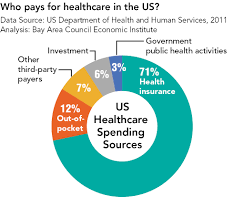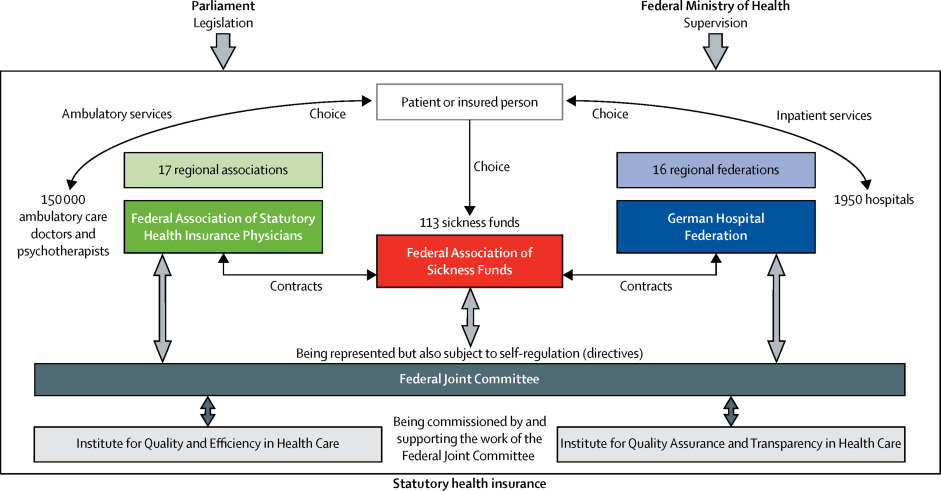Introduction
Both Germany and the United States of America are developed countries with one of the highest qualities of life. Medicine would not be an exception for these two countries. This presentation will discuss the healthcare systems of both the US and Germany and analyze which aspects of the latter could be useful to implement in the states.
The US Health Care System
The healthcare system in the United States of America has been a leader in many rankings for many years in a row, both in terms of the scale of resources concentrated in it and in terms of the level of scientific research results.
The development of the healthcare system is one of the priorities of the US government. In 2016, America spent $3.3 trillion in this direction, which amounted to $10,348 per person – this is significantly more than the costs of other developed countries. And if you analyze the market of today’s American pharmacology, you can see that half of all medicines created recently are in the USA. But here it is important to make a remark – many doctors and scientists who have succeeded in this matter in America are far from always Americans. This country attracts the best foreigners to study and work thanks to numerous programs, grants, as well as salaries, the level of which significantly exceeds the earnings of doctors from other countries (Young & Kroth, 2017).
The USA has achieved high rates in the field of neurology, transplantology and oncology, heart surgery, and plastic surgery, which is why America is one of the countries with highly developed medical tourism.
The Germany Health Care System
The German healthcare system works like all German mechanisms – precisely and with maximum efficiency. And this is not surprising because its principles of social equality and access to medical care were still laid down by the “Iron Chancellor” – Otto von Bismarck. The system has had enough time to improve and evolve into one of the best healthcare systems in the world.
With the policy of one or another insurance company, the so-called sickness fund (Krankenkasse), the patient can receive outpatient or inpatient medical care. There is also a rescue service (Rettungsdienst), which is designed to help in cases requiring urgent intervention (Walzer, 2022).
Access to Healthcare in the US
Private insurance can be individual or group (for example, a company buys insurance for its employees). Most Americans with private health insurance get it from their employers. According to the USCB, about 60% of US citizens have employer-sponsored insurance, and only 9% of Americans purchase it personally.
In 2008, more than 95% of US employers with more than 50 employees offered corporate insurance to their employees. Today, the country is taking active measures to encourage employers to buy health insurance for employees. For example, effective January 1, 2014, under the Affordable Care Act, businesses with more than 50 employees have to pay an additional $2,000 in tax if they don’t insure their staff (Young & Kroth, 2017).
Many colleges, vocational schools, and universities also offer school-funded health insurance to students. Some schools even require participation in their sponsored insurance programs or proof that the student already has comparable health insurance.
The Consolidated Omnibus Budget Reconciliation Act (COBRA) plan helps Americans stay on health insurance for a while if they lose their job and source of income. Eligibility for such a program is determined, among other things, by the reason for leaving work.
Other systems of insurance operate in the country. For example, for military personnel and veterans, as well as a health insurance system for Native Indians.
Approximately 95% of Americans and those who are equal to them in rights (green card holders) have insurance. Many have insurance that includes family members, which allows them to save a lot on medical care, but nevertheless does not allow them to receive full medical care, which is familiar to Russians. If, for some reason, there is no insurance, a single visit to the doctor will result in $ 100-150 (Young & Kroth, 2017).
This leads to the fact that people without health insurance practically do not visit doctors, in extreme cases, turning to the “ambulance.” However, this is not suitable for every situation. For example, there is often no good dentist in emergency care.
Access to Health Care in Germany
Outpatient medical care primarily includes private offices (Praxis), and sometimes there is an outpatient appointment at hospitals. A private office can be opened by any doctor with a specialization (Facharzt). Approximately 45% of all doctors work mainly in private offices. The number of such offices is limited by the quota for a particular city or town.
Family doctors own more than half of all private offices. As a rule, the family doctor is the first doctor to whom the patient comes, and if the doctor cannot help the patient on his own, he gives a referral to a specialist. A specialist doctor can work either alone or in a group with other doctors (such as 25%), thus forming entire medical centers. Doctors of related specialties, for example, an orthopedist and a therapist or a surgeon and a gynecologist, can also work in one private office, but not an ophthalmologist and gynecologist.
Approximately 5% of all private practitioners have the right to treat their patients in hospitals (Belegarzt). So, for example, a surgeon can perform minor surgical interventions in his office, but the same doctor has the right to perform major interventions only in a hospital. After that, the doctor visits these patients once or twice a day, and the doctors working at the hospital monitor these patients the rest of the time (Walzer, 2022).
There are over 2,000 hospitals in Germany. All clinics can be divided into three categories:
- state (54%)
- private (8%)
- charities (38%).
Quality of Health Care in the US
To begin with, it is necessary to pay tribute to the technical equipment of the entire industry. The healthcare system conducts its activities using the most advanced technologies. Ideal medical equipment that meets the latest technology, medicines that act comprehensively and quickly without affecting other systems other than the one they are focused on, and excellent consumables (Austin & Wetle, 2016).
All this helps medicine in the United States to maintain its high level.
The Institute of Medicine has a strong lobby in the government sector, thanks to which all bureaucratic issues are resolved quickly, whether it is the need for equipment or innovative technologies. By the way, the Institute of Medicine does not hesitate to attract promising personnel from other countries.

Quality of Health Care in Germany
Health care in Germany is considered to be one of the best qualities in Europe. There are several reasons for this statement:
The patient has an electronic card that displays his data, medical history, and examinations. This innovation allows you to be examined in any hospital in Germany without creating a new hospital card for each new hospital (Dutton, 2021).
The patient has the right to choose the hospital in which he wants to be treated, which only applies to hospitals in Germany that are part of the public health system.
Every resident of the country has the right to receive additional insurance from a private insurance organization.
A patient with Supplemental Insurance from the National Insurance Fund may receive free outpatient treatment.
Every patient has the right to receive treatment in the required hospital, regardless of where the referring doctor works.
Children (under 18) and the elderly are entitled to free treatment (Dutton, 2021).

Price of Health Care in the US
Healthcare spending in the United States is one of the highest in the world: in absolute terms, it is more than seven thousand dollars per person per year, and the ratio of costs to GDP per capita is 16%. It should also be noted that representatives of America most often receive the Nobel Prize in Medicine (Austin & Wetle, 2016).
Price of Health Care in Germany
Those working in Germany with a salary of fewer than 57,600 euros per year (4,800 euros per month in 2017) immediately after signing an employment contract must register with the public health system (Gesetzliche Krankenversicherun or GKV) and take out a health insurance policy (Walzer, 2022).
Approximately 110 non-profit associations (Krankenkassen) are responsible for enrolling in the German statutory health insurance scheme, charging the same fixed fee of 14.6% of wages, not exceeding 4,350 euros per month (52,200 euros per year) in 2017. Subject to higher incomes, the amount of the fee will also not exceed 4350 euros per month.
The employer covers half of this fee (7.3%). The term of the insurance contract drawn up by the employer is usually 18 months, after which it is possible to change the insurance program. Employees pay the fee only for wages not exceeding 850 euros per month (Dutton, 2021).
In 2017, the rate set was 2.55% of the total salary (or 2.8% for those without children), a maximum €110.93 per month (or €121.80 for those without children), with half of the cost covered by the employer (Walzer, 2022).
Conclusion: Learning from German Example
As the presentation shows, there are several factors that make the German healthcare system more beneficial in terms of money management and accessibility.
Firstly, the digitalization of medical cards allows patients to use services from different hospitals without losing important data.
Then, the German health care system is the concern not only of the government but also of the employer. The system is built for both of them to contribute to people’s safety and comfort. That way, the employed population builds more trust in the company they work for and in the government, too.
Finally, the government supports children and the elderly who are unable to finance themselves. Therefore, the overall accessibility is significantly higher compared to the US.
Possible Benefits
By implementing several policies of the German health care system, the US can benefit in several ways:
- Medicine would become more accessible to the public, despite their employment status.
- Storing data of patients and providing more quality care would be easier with digital technologies implementation.
- The population would be more motivated to be employed, knowing that both government and the employer are ready to provide health insurance and care for their well-being.
References
Austin, A., & Wetle, V. (2016, January 5). United States Health Care System, The: Combining Business, Health, and Delivery (3rd ed.). Pearson.
Dutton, P., V. (2021, April 15). Beyond Medicine: Why European Social Democracies Enjoy Better Health Outcomes Than the United States (The Culture and Politics of Health Care Work). ILR Press.
Walzer, S. (2022, May 11). Digital Healthcare in Germany: Market Access for Innovations (Contributions to Economics)(1st ed. 2022). Springer.
Young, K. M., & Kroth, P. J. (2017, February 22). Sultz & Young’s Health Care USA: Understanding Its Organization and Delivery: Understanding Its Organization and Delivery (9th ed.). Jones & Bartlett Learning.